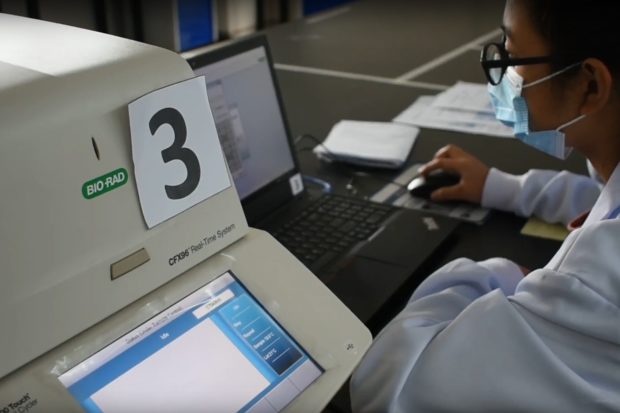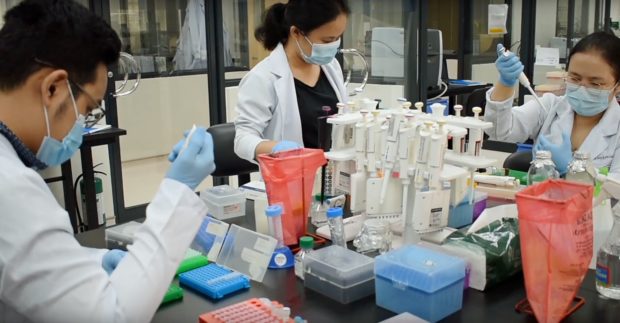Scientists all eyes on mutations

POWERFUL MACHINE The scientists — all in their 20s and 30s — use the NovaSeq 6000, a $1-million genome sequencing machine to conduct large-scale “whole-genome sequencing” on specimen samples that carry the SARS-CoV-2, the causative agent of COVID-19. CONTRIBUTED/ UP PHILIPPINE GENOME CENTER
The University of the Philippines’ Philippine Genome Center (UP-PGC) is home to cool young adults who play tabletop Dungeons and Dragons, gush over Korean actors, and relax over milk tea after work.
But for them the pandemic front line is a whole new ballgame that requires a punctilious stance against a real-life threat. Equipped with the NovaSeq 6000, a $1-million genome sequencing machine acquired in 2017, UP-PGC leads the Philippines’ biosurveillance.
The powerful machine, the only one in the country, conducts large-scale “whole-genome sequencing” on specimen samples that carry the SARS-CoV-2, the causative agent of COVID-19, finds significant mutations in the virus’ spike protein, and makes sense of the patterns in its 30,000-letter-long RNA.
This is important because mutations can increase the virus’ virulence, allow it to evade detection, or even resist vaccines.
Virus trackers

VIRUS TRACKERS Dozens of molecular biologists, medical technicians and computer scientists work round the clock at the PGC laboratory in UP Diliman, Quezon City, to conduct biosurveillance, including finding significant mutations in the virus’ spike protein. CONTRIBUTED/ UP PHILIPPINE GENOME CENTER
Without biosurveillance, “we would all be moving blindly through this pandemic, not knowing whether variants of concern are driving our spike in cases,” PGC director Dr. Cynthia Saloma said in an online interview.
Article continues after this advertisementDozens of molecular biologists, medical technicians and computer scientists—all in their 20s and 30s—work almost nonstop at the PGC laboratory in UP Diliman, especially since SARS-CoV-2 variants of concern (VOC) began to emerge in December.
Article continues after this advertisementBefore becoming “virus-trackers,” they studied mostly bacteria, animal models such as mice, or sequenced genes in cancer cells.
“Basically normal stuff except for some nerdy board games,” bioinformatics specialist Francis Tablizo, 34, said when asked what he usually did during his downtime.
Some are active on social media but are quite restrained in sharing their findings.
As standard operating procedure, only the Department of Health (DOH), which also selects the anonymized samples for sequencing, can make public the results that the PGC turns in every week.
In January, the DOH confirmed the first case of a variant that originated overseas—a B.1.1.7 in a 29-year-old man who returned to the Philippines from Dubai.
The B.1.1.7 was first reported in the United Kingdom (UK) and, like the rest of the VOC subsequently detected in the Philippines, was said to be more contagious than the original virus first reported in Wuhan, China.
The Philippine government promptly tightened the borders and increased contact tracing for VOC.
“There was no official report from Dubai of [the] B.1.1.7 despite the clear risk, with thousands of UK travelers spending their holidays there. It was not [on] the list of the World Health Organization,” Saloma recalled.
To her, this spoke volumes about the Philippines’ potential to work at par with the international science community.
But, being hamstrung by a global shortage of chemical reagents, gene-sequencing is simply an “overwhelming” task, said Candice Tambaon, who graduated with a degree in molecular biology last year.
“There’s [also] a lot of pressure not to make any mistake,” said Irish Coleen Asin, another molecular biologist.
Some are dealing with work stress or discrimination at home, given the risk of exposure to the virus in the lab.
Others, like Shiela Mae Araiza and Kris Punayan of the gene-sequencing team, have not gone home to General Santos City in Mindanao since the start of the community lockdowns. They stay in the university dormitories and ride bicycles to work.
Sequencing
The UP-PGC sequences a batch of 750 samples a week—a rate that follows global standards but which some doctors say is not enough to get a bigger picture of the current surge.
According to lab technician Ma. Exanil Plantig, her work starts at midnight to extract the virus RNA, either mechanically or manually. It then takes several rounds of polymerase chain reaction (PCR) tests—the process of about four to five hours for such a large sample size.
The PCR products—a library of indexed fragments of DNA—are then run on the sequencing machine.
Sequencing takes two-three days, after which the data are analyzed using specialized computer programs.
“It’s like assembling puzzle pieces to form an image of the genetic material. From there, you trace the lineages and analyze how the virus is transmitted from person to person, place to place,” Tablizo said.
The UP-PGC has requested an additional P360 million for the entire SARS-CoV-2 surveillance effort. This will cover human resources and purchase of additional reagents, computer servers, and storage freezers to preserve specimen samples collected in the provinces.
Bioinformatician Carlo Lapid said it was an “interesting position,” considering how their findings impacted state policies. “We always have to get [the results] right. Exciting and scary challenge, but we hope to live up to the needs of the country,” he said. INQ